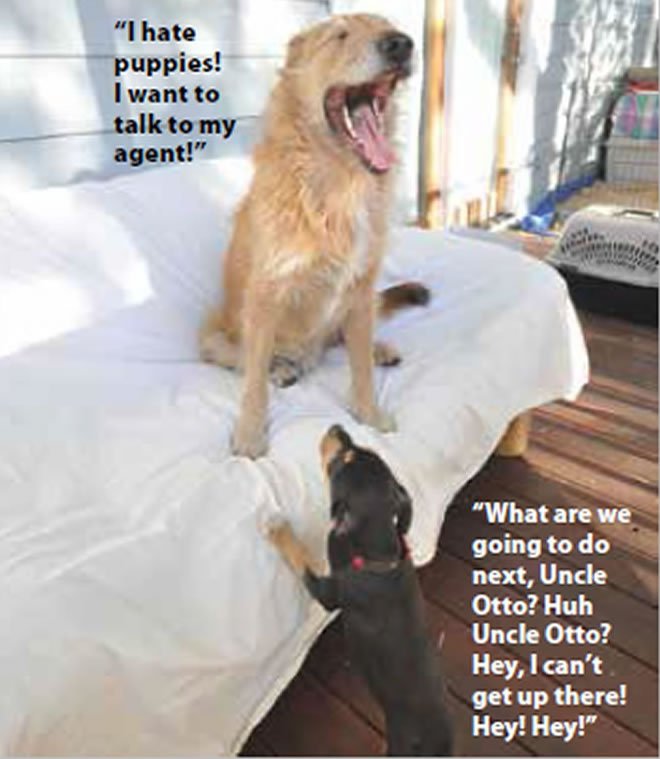
You thought you were doing a good thing for your mature dog when you adopted a new puppy. “She’ll love him!” you assured yourself. “It will keep her young and active.” Rather than loving him, however, your senior girl has let you know in no uncertain terms that this young upstart is a pain in her tail. What do you do when your pesky puppy or active adolescent is making life miserable for your sedate senior? Here are five things that can help:
1. Protect your mature dog.
To some degree, adult dogs can be allowed to appropriately let youngsters know when they are being obnoxious. If your dog thoughtfully reprimands your pup when he’s using her ears or tail as a chew toy, let her. If the pup fails to back off, however, or in general is just too wild and crazy for your mature girl, she is likely to escalate to an inappropriate level of aggression just to defend herself. This can frighten or injure the pup, and create a lifelong tension-filled relationship between the two. Always actively supervise when the two are together, and when the younger dog’s energy is too much, protect your senior dog by intervening so she doesn’t have to. Give the pup a five-minute timeout in his crate or exercise pen, and if he calms sufficiently, let him rejoin the fun. If he’s still too aroused, keep him away from her until he settles.
2. Manage the youngster.
Your adult dog may long for the days when she could laze around the house, stretched out in a sunbeam, without worrying about a 25-pound missile landing on her ribcage. Give that back to her by providing plenty of time when the two dogs are physically separated. They can have separate halves of the house (baby gates are a must-have for multi-dog management), or the youngster can be crated or corralled in an exercise pen if he’s not yet ready for house freedom. Even if you are home, keep them separated for your older dog’s peace of mind except when you are actively supervising.
3. Exercise the younger dog.
Your young dog will be easier to live with for you as well as for your adult girl if you keep him well exercised (i.e., tired). Well-matched canine playmates can do a superb job of keeping each other suitably tired. However, don’t expect your senior girl to be your young dog’s workout coach; she’s already telling you she’s had more than enough of his energy. Find another dog closer to your pup’s age and energy level, and arrange frequent playdates. Both households will be calmer and happier for it, and your mature dog will thank you.
4. Train him, too!
Of course your youngster needs training for his own sake, but teaching him good manners behaviors will also make life easier for your adult dog. You’ll be able to direct him to leave her alone with a cheerful “Go to your mat!” cue, and a good series of training classes will help your pup learn better impulse control and be calmer and better behaved all around.
5. Spend one-on-one time with each dog.
One of the motives for getting a second dog is often to provide companionship for the first. While that’s all well and good, it still shouldn’t take the place of your attention, especially for your original dog, who may be accustomed to – and cherish – her alone time with you. If you thought you were saving time by getting a second dog, think again. You now need to carve out one-on-one time for each dog – the first so she isn’t deprived of the special relationship you created in your years together, and the second so you can create an equally special relationship with him that you will cherish for many years to come.
Pat Miller is WDJ’s Training Editor.




